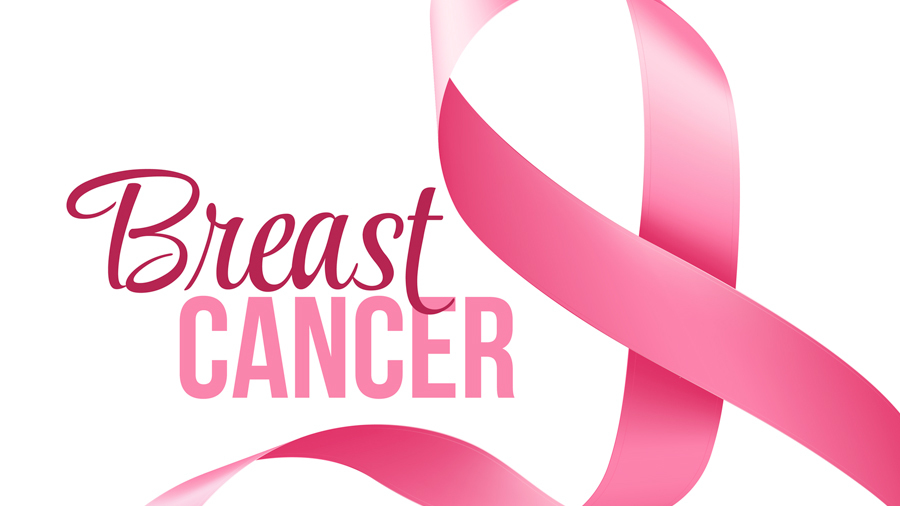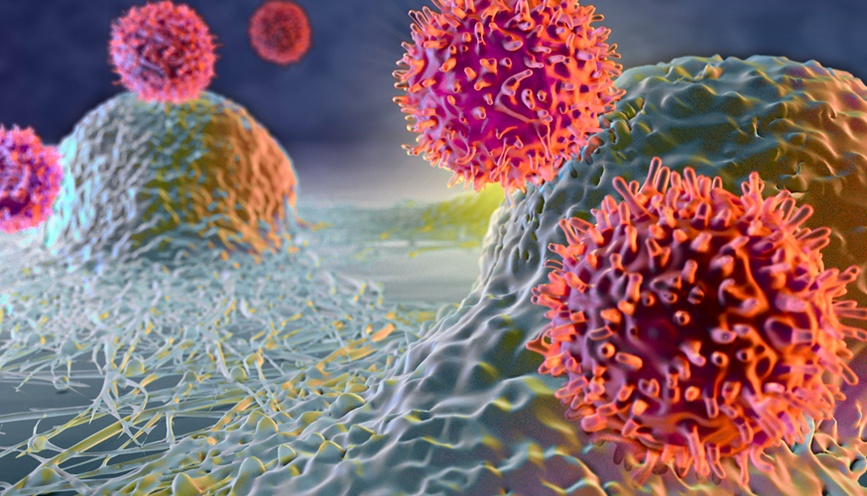Breast cancer is a condition in which breast cells multiply in an uncontrollable manner. There are diverse kinds of breast cancer. The nature of breast cancer varies according to the breast cells that transform into cancer. Breast cancer can spring in diverse sections of the breast. A breast is comprised of three principal parts, namely, the connective tissue, the channels, and the lobules. While the lobules are responsible for milk-producing, the ducts are the tunnels that carry the milk to the nipple, and the connective tissue (which is constituted of fibrous and adipose tissues) encompasses and keeps everything in position. The majority of breast cancers originate in the lobules or canals. Breast cancer can reach the surface of the breast through lymphatics and the blood vessels. When breast cancer reaches to other portions of the body, it is supposed to have metastasized.
Types of Breast Cancer
The most prevalent kinds of breast
cancer currently known to doctors and researchers are –
- Invasive
Ductal Carcinoma
Cancer cells develop outside the canals in other portions of the breast tissue. Invasive cancer cells can additionally increase, or metastasize, to other sections of the body.
- Invasive
Lobular Carcinoma
Cancer cells disperse lobules to closely located breast tissue. Certain invasive cancer cells can also scatter to different sections of the body.
- There are numerous other varieties of aggressive breast cancers, which are quite rare, including mucinous, inflammatory, and medullary breast cancers as well as Paget’s disease. DCIS (Ductal Carcinoma in Situ) is a breast disorder that can cause breast cancer. The cancer cells are observed particularly in the wall of the ducts and do not disseminate to additional breast tissues.
The Effects of Breast Cancer on the Body
Listed below in detail are all possible effects for those wondering which part of the body does breast cancer affect as well as what does breast cancer look like.
- Stages
Of Breast Cancer
In the start, breast cancer only attacks the breast region. One may not be able to discern differences in their breasts themselves. The additional traits are not so apparent until one detects them through self-examination. Sometimes your physician may also detect breast cancer growths on a mammogram or additional imaging devices before you discern some signs of breast cancer. Similar to other cancers, breast cancer develops in stages. Stage 0 is the most primitive stage with the least amount of obvious manifestations. Stage 4 symbolizes that the cancer has expanded to additional sections of the body. If breast cancer expands to different portions of the body, it can also produce indications in certain selective regions. Affected regions may comprise the brain, muscles, lungs, liver, and bones. The immediate consequences of breast cancer may depend on the precise variety of breast cancer that one might have.
- Changes
To The Breasts
Breast cancer normally begins in one of the breasts. The most obvious indication of breast cancer is a recently developed lump or tumor in the breast. Size or volume is normally sporadically formed and painless. However, some malignant tumors can be severe and spherical in appearance. This is why any lump or tumor should be scanned for cancer. Invasive ductal carcinoma creates bumps and bulges in the breasts. It is a variety of breast cancer that develops within the milk tubes. Invasive ductal carcinoma is also the most prevalent sort of breast cancer, accounting for more than half of all diagnoses. It is also more inclined to expand to other sections of the body. Invasive lobular carcinoma can induce breast thickening. This sort of breast cancer commences in the milk-secreting organs. It is approximated that up to fifteen percent of all breast carcinomas are invasive lobular carcinomas. One may notice that their breasts have shifted in tone or volume. They can also be red or inflated as a result of a cancerous growth. Although breast carcinomas are ordinarily not painful, the resulting inflammation can induce pain. Malignant tumors can nevertheless be painful in unusual circumstances. In the occurrence of breast carcinoma, one’s nipples can likewise experience notable differences. One can observe clear liquids coming out of their nipples, even if they are not currently breastfeeding. Sometimes the secretion also comprises a tiny quantity of blood. The nipples themselves can also curve inside.
- Skin
Changes
Apart from the modifications to the breasts themselves, breast carcinoma can also influence the skin encompassing them. It can be remarkably bothersome and can become dehydrated and damaged. Some women’s breasts also happen to feature a lot of dimples on them. The thickening of the breast mass is also prevalent in breast cancer.
- Immune
and Excretory Systems
In the advanced stagings of breast carcinoma, tumors tend to expand to different lymph nodes. The armpitsare the first place breast cancer spreads to. This is because of their close proximity to the breasts. One can observe tenderness and inflammation in their underarms, in such cases. Other ganglionic operations may be influenced by the lymphatic system. Although this system is usually accountable for transferring a wholesome lymph fluid all over the body, it can likewise expand malignant tumors. Tumors can radiate via the lymphatic system to the liver and lungs. If the lungs get attacked, one could experience shortness of breath, cough, chronic ailments, as well as additional breathing complications. When cancer strikes the liver, one may encounter stubborn abdominal bloating, jaundice, as well as edema ( which the retention of excess water) in the muscular and skeletal systems. Breast cancer can also expand to the bones and muscles. One can then endure discomfort in these regions as well as restricted movements. The joints may seem tense, particularly after one gets up or stands for extended intervals of time. Such outcomes can also enhance your chance of impairment due to a loss of movement. Bone fractures are additionally a hazard.
- Nervous
System
Breast cancer can also disperse to the brain. This can point to a multitude of neurological outcomes including blurred or doubled vision, disorientation, neuralgia, memory impairment, mobility difficulties, mumbled articulation, and seizures. Other symptoms include extreme tiredness, frailty, lack of hunger, and unwarranted weight loss.
Popular Treatments
Breast cancer is handled in numerous methods and it depends on the nature of breast cancer and its scope. People with breast cancer often times profit from more than one sort of treatment.
- Chemotherapy
This involved the application of specific medications to diminish or destroy cancer cells. Medicines can be either pills that one takes, medicines that are administered through the veins, or sometimes both. It is recognized that chemotherapy can be beneficial for numerous breast cancer patients. Albeit it is difficult to foretell who will profit the greatest or the least as this is still under investigation. Sometimes chemotherapy induces notable side effects (both short term and long term). It would, consequently, be beneficial to undergo inspections to decide who actually requires chemotherapy. Many studies are advancing to assess various tests to discover more accurately which patients would profit from chemotherapy and those who should avoid it entirely.
- Hormonal
Therapy
Hormonal therapy assists in preventing cancer cells from receiving the hormones that they require to develop. This therapy fights with the body’s immune system to further attack cancer cells or restrain the side effects of additional cancer therapies.
- Radiotherapy
This therapy involves the usage of high energy rays, which are comparable to X-rays, in order to destroy tumor cells. Doctors of diverse practices oftentimes operate together to tackle breast cancer. Radiation oncologists are specialists who tackle cancer through radiation.
- Supplementary
& Alternative Medications
Supplementary and alternative remedies are drugs and wellness practices that are not conventional cancer therapies. Supplementary medication is utilized in extension to conventional therapies, and alternative medication is utilized rather than conventional approaches. Many sorts of companion and alternative medications have not been reliably examined and may not be reliable. That is why it is important for breast cancer patients to discuss things with their doctors before beginning any sort of supplementary or alternative medication.
- Triple-Negative
Breast Cancer
Owing to the fact that TNBC (Triple-Negative Breast Cancers) cannot be managed with hormone therapy or targeted treatments including HER2, treatment alternatives are confined to chemotherapy. Moreover, while TNBC favors primary chemotherapy, it tends to yield more often in other types of breast carcinomas.
Other possible objectives for new breast cancer medications have been recognized in recent times. Drugs based on certain targets, including kinase inhibitors, are now being investigated to tackle triple-negative breast cancers, both individually and in union with chemotherapy. An instance is an AKT inhibitor called ‘Ipatasertib‘, that, when applied with ‘Paclitaxel‘, presents encouraging outcomes for treating women with TNBC as the primary therapy. Another AKT inhibitor called ‘Capivasertib‘ also presents promising outcomes when delivered in conjunction with ‘Paclitaxel‘.
The Future of Breast Cancer Research
Researchers continue to scan for medications that can diminish the chance of contracting breast cancer, particularly for women who are at tremendous risk. Estrogen inhibitors are customarily utilized to tackle breast cancer, but some can also assist in preventing it entirely. Raloxifene and Tamoxifen and have been utilized for numerous years to inhibit breast carcinoma. More modern studies of another class of medications termed as ‘Aromatase Inhibitors‘ have revealed that these medications are also very efficient in halting breast carcinoma.
Other clinical tests involve non-hormonal medicines for breast cancer remission. Remedies of interest include diabetes medicines, drugs utilized to handle blood and bone marrow complications, and a medication that tackles a specific kind of cell lymphoma. This sort of analysis needs extensive years of research. It may necessitate some time before meaningful outcomes for any of these composites are available. Trials concentrate on distinctive remedies to enhance memory and cerebral manifestations after chemotherapy. Other investigations are assessing whether specific heart prescriptions, identified as beta-blockers, can inhibit heart illness sometimes provoked by conventional anti-cancer medications.


